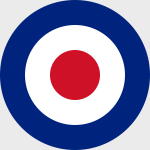oOxford OXFAC128 RAF De Havilland Mosquito Mk.II Night Fighter - Peter Wykeham-Barnes, No.23 Squadron, Malta (1:72 Scale)
"For some men of great courage and adventure, inactivity was a slow death. Would a man like Gibson ever have adjusted back to peacetime life? One can imagine it would have been a somewhat empty existence after all he had been through. Facing death had become his drug. He had seen countless friends and comrades perish in the great crusade. Perhaps something in him even welcomed the inevitability he had always felt that before the war ended he would join them in their Bomber Command Valhalla. He had pushed his luck beyond all limits and he knew it. But that was the kind of man he was - a man of great courage, inspiration and leadership. A man born for war - but born to fall in war."
- Barnes Wallis discussing the death of Guy Gibson, September 1944
 The "Mossie," as it was known affectionately by its British crews, was both simple in construction and design. It was a twin engine, single boom aircraft that placed the pilot and navigator in a side-by-side sitting configuration. The Mosquito was one of the most cost effective aircraft ever built because it was constructed out of wood. Balsa was used for the plywood skin, Sitka spruce from Alaska and British Columbia for the wing spars, and Douglas Fir stringers and birch and ash for the longitudinal pieces. These were all held together with glue and wood screws. The result was an airplane that was easy to maintain, tolerant of battle damage, and simple to patch. It was faster than the Spitfire, flew higher than almost any other aircraft, and carried tremendous firepower over great distances. The bomber version operated with relative impunity over Germany til the end of the war, because the Luftwaffe never had a nightfighter fast enough to intercept it. Interestingly, the nightfighter versions of the Mosquito remained in production until 1947, two years after the war in Europe had ended.
The "Mossie," as it was known affectionately by its British crews, was both simple in construction and design. It was a twin engine, single boom aircraft that placed the pilot and navigator in a side-by-side sitting configuration. The Mosquito was one of the most cost effective aircraft ever built because it was constructed out of wood. Balsa was used for the plywood skin, Sitka spruce from Alaska and British Columbia for the wing spars, and Douglas Fir stringers and birch and ash for the longitudinal pieces. These were all held together with glue and wood screws. The result was an airplane that was easy to maintain, tolerant of battle damage, and simple to patch. It was faster than the Spitfire, flew higher than almost any other aircraft, and carried tremendous firepower over great distances. The bomber version operated with relative impunity over Germany til the end of the war, because the Luftwaffe never had a nightfighter fast enough to intercept it. Interestingly, the nightfighter versions of the Mosquito remained in production until 1947, two years after the war in Europe had ended.
Pictured here is a 1:72 scale replica of a RAF De Havilland Mosquito Mosquito Mk.II night fighter that was piloted by Peter Wykeham-Barnes. who was attached to No.23 Squadron, then deployed to Malta.
Pre-order! Ship Date: 2025.
Dimensions:
Wingspan: 9-inches
Length: 6-3/4-inches
Release Date: ?
Historical Account: "Fighter Command" - Wykeham-Barnes joined the Royal Air Force as an apprentice in 1932. He served in the Second World War as a Flight Commander with No. 274 Squadron and as Officer Commanding No. 73 Squadron before commanding the fighters at Headquarters Desert Air Force. He continued his war service as Officer Commanding No. 257 Squadron and then as Officer Commanding No. 23 Squadron before becoming Sector Commander at RAF Kenley and then commanding No. 140 Wing.
Remaining in the RAF after the War, Wykeham-Barnes was employed as a test pilot before serving with the USAF Fifth Air Force in the Korean War. On his return to Great Britain, Wykeham-Barnes served as station commander at RAF North Weald and then RAF Wattisham before becoming Assistant Chief of Staff (Operations) at Headquarters Allied Air Forces Central Europe in 1953. He went on to join the Air Staff (Operations) at Headquarters RAF Fighter Command in 1956 and became Director of Fighter & Theatre Air Force Operations in 1958. He served as Air Officer Commanding No. 38 Group from 1960, the Director of the Joint Warfare Staff from 1962, the Commander of the Far East Air Force from 1964 and the Deputy Chief of the Air Staff from 1967 before retiring in 1969.


